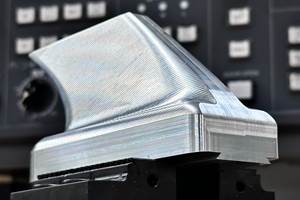Helping Machine Operators with Math
Requiring machine operators to perform calculations repeatedly has a negative impact on productivity.
Share






Any time you see a machine operator or setup person using a calculator, pay attention: There is probably something you can do to help them and improve productivity. With all we expect of these people, why add to their work? Performing calculations takes time and can sometimes lead to mistakes and scrapped parts. Plus, a machine might sit idle while a calculation is performed, which can add to the time it takes to complete a setup or production run.
Suggestions for facilitating or eliminating calculations fall into the category of task simplification. I regularly hear managers start a sentence with, “A good operator should be able to...” and then complete the sentence with just about any imaginable task, regardless of its complexity or time-consuming nature.
A math-related completion to this sentence might be, “A good operator should be able to calculate values needed for program-zero assignments.” Other tasks include calculating a thread’s pitch diameter after measuring over pins, calculating the speed and feed for a cutting tool, calculating the depth of a through hole and calculating the angle of taper on a workpiece.
The list continues. While a good operator should be able to perform these calculations, why would we want them to? This is especially true if it takes time and introduces the potential for mistakes. If there is a way to facilitate or eliminate these calculations, find it and implement it. Doing so will, at the very least, save production time. More likely, it will reduce the number of mistakes and minimize their impact on production.
So, when do you see your machine operators reaching for calculators? Is it every setup or every cycle? The more times the calculation is repeated, the bigger impact that facilitating or eliminating the calculation will have. You must find realistic, feasible and appropriate ways to facilitate or eliminate the time-consuming calculations your machine operators make.
For example, maybe you have a bar-fed turning center and the setup person must calculate how many workpieces can be run from each bar and how many bars must be run to complete an order. Eliminate the calculations by incorporating a part-counting custom macro that enables a simple entry for the number of workpieces to be produced. The custom macro will stop the cycle once the final part count has been achieved.
Maybe your machine operators primarily work in the metric system but must sometimes work in the imperial system. Find ways to keep them from having to perform any conversions between measurement systems. For example, utilize electronic measuring tools that can be easily set and calibrated for either measurement system mode. Incorporate programs that fully utilize the measurement system mode being used. That is, do not run workpieces dimensioned in the metric system with a program that has been written using the imperial system with converted coordinates. That way, all offsets can be specified in the measurement system originally used to dimension the part.
If you expect your machine operators to occasionally perform trigonometry calculations, find ways to help. A custom program on a mobile device could enable operators to input known values and receive the needed answers without performing the calculations themselves. For example, the machine operator may be measuring workpieces on a surface plate using a sine bar. Develop the needed calculation in a tablet or computer program that enables the operators to easily enter their measured value/s and make the mobile device respond with the answers they were previously calculating.
These are but a few suggestions. As you walk the shop floor, look for operators using calculators. Then, be aggressively aware. Is there anything you can do to help? Given the potential for improving productivity, do not be too quick to say no.
Indeed, good operators may think that simplifying calculation-related tasks is “dumbing down” the work they do and resent it. To a point, they are correct. Simplified tasks can be performed by people of lower skill levels. Make it clear that your goal is to free up some of their time, possibly so they do not have to work so hard to get their work done, or possibly so they have time to complete other, more important tasks.
Related Content
How to Meet Aerospace’s Material Challenges and More at IMTS
Succeeding in aerospace manufacturing requires high-performing processes paired with high-performance machine tools. IMTS can help you find both.
Read MoreTips for Designing CNC Programs That Help Operators
The way a G-code program is formatted directly affects the productivity of the CNC people who use them. Design CNC programs that make CNC setup people and operators’ jobs easier.
Read MoreHow to Evaluate Measurement Uncertainty
Manufacturing and measurement are closely coupled. An important consideration for the use of measurement results is the associated measurement uncertainty. This article describes common metrology terms and provides an example uncertainty analysis.
Read MoreCustom Workholding Principles to Live By
Workholding solutions can take on infinite forms and all would be correct to some degree. Follow these tips to help optimize custom workholding solutions.
Read MoreRead Next
Machine Shop MBA
Making Chips and 91ÊÓƵÍøÕ¾ÎÛ are teaming up for a new podcast series called Machine Shop MBA—designed to help manufacturers measure their success against the industry’s best. Through the lens of the Top Shops benchmarking program, the series explores the KPIs that set high-performing shops apart, from machine utilization and first-pass yield to employee engagement and revenue per employee.
Read MoreAMRs Are Moving Into Manufacturing: 4 Considerations for Implementation
AMRs can provide a flexible, easy-to-use automation platform so long as manufacturers choose a suitable task and prepare their facilities.
Read MoreLast Chance! 2025 Top Shops Benchmarking Survey Still Open Through April 30
Don’t miss out! 91ÊÓƵÍøÕ¾ÎÛ's Top Shops Benchmarking Survey is still open — but not for long. This is your last chance to a receive free, customized benchmarking report that includes actionable feedback across several shopfloor and business metrics.
Read More.jpg;width=70;height=70;mode=crop)






















